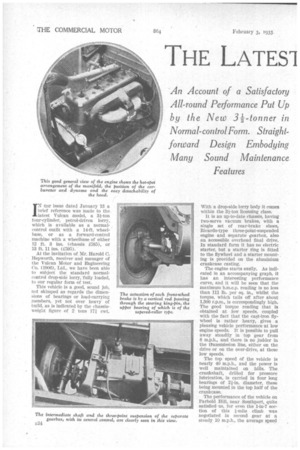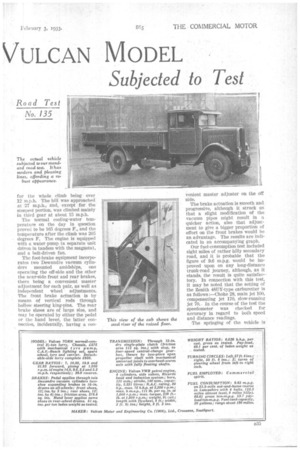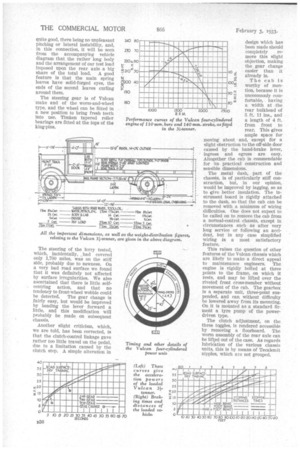THE LATES1 VULCAN MODEL
Page 48

Page 49

Page 50

If you've noticed an error in this article please click here to report it so we can fix it.
Subjected to Test
An Account of a Satisfactory All-round Performance Put Up by the New 3Ponner in Normal-control Form. Straightforward Design Embodying Many Sound Maintenance IN aur issue dated January 13 a brief reference was made to the latest Vulcan model, a 3i-ton four-cylinder, petrol-driven lorry, which is available as a normalcontrol outfit with a 14-ft. wheelbase, or as a forward-control machine with a wheelbase of either
12 ft. 3 ins. (chassis £585), or 13 ft. 11 ins. (£595).
At the invitation of Mr. Harold C. Hepworth, receiver and manager of the Vulcan Motor and Engineering Co. (1906), Ltd., we have been able to subject the standard normalcontrol drop-side lorry; fully loaded, to our regular form of test.
This vehicle is a good, sound job, not skimped as regards the dimensions of bearings or load-carrying members, yet not over heavy of build, as is indicated by the chassisweight figure of 2 tons 17i cwt. With a drop-side lorry body it comes within the 3i-ton licensing class.
It is an up-to-date chassis, having two-servo vacuum brakes, with a single set of rear-brake shoes, Ricardo-type three-point-suspended engine and separate gearbox, also an accessible overhead final drive. In standard form it has no electric starter, but a starter ring is fitted to the flywheel and a starter mounting is provided on the aluminium crankcase casting.
The engine starts easily. As indicated in an accompanying graph, it has an interesting performance curve, and it will be seen that the maximum b.m.e.p. reading is no less than 111 lb. per sq. in., whilst the torque, which tails off after about 1,300 r.p.m., is correspondingly high. The good torque reading that is obtained at low speeds, coupled with the fact that the cast-iron flywheel is rather heavy, gives a pleasing vehicle performance at low engine speeds. It is 'possible to pull away steadily in top gear from 8 m.p.h., and there is no judder in the Cansmission line, either on the drive or on the over-drive, at these low speeds.
The top speed of the vehicle is nearly 40 m.p.h., and the power is well maintained on hills. The crankshaft, drilled for pressure lubrication, is carried in four long bearings of 21-in. diameter, these being mounted in the top half of the crankcase.
The performance of the vehicle on Parbold Hill, near Southport-, quite satisfied us, for even the 1-in-7 section of this 1-mile climb was negotiated in second gear at a steady 10 m.p.h., the average speed for the whole climb being over 12 m.p.h. The hill was approached at 27 m.p.h.; and, except for the steepest portion, was climbed mainly in third gear at about 15 m.p.h.
The normal cooling-water temperature on the day in question proved to he 165 degrees F., and the temperature after the climb was 205 degrees F. The engine is equipped with a water pump (a separate unit driven in tandem with the magneto), and a belt-driven fan.
The foot-brake equipment incorporates two Dewandre vacuum cylinders mounted amidships, one operating the off-side and the other the near-side front and rear brakes, there being a convenient master adjustment for each pair, as well as independent wheel adjustments. The front brake actuation is by means of vertical rods through hollow steering king-pins. The rear brake shoes are of large size, and may be operated by either the pedal or the hand lever, the latter connection, incidentally, having a con venient master adjuster on the off side.
The brake actuation is smooth and progressive, although it struck us that a slight modification of the vacuum pipes might result in a quicker action, also that adjustment to give a bigger proportion of effort on the front brakes would be an advantage. The results are indicated in an accompanying graph.
Our fuel-consumption test included eight miles of rather hilly secondary road, and it is probable that the figure of 9.6 m.p.g. would be improved upon on any long-distance trunk-road journey, although, as it stands, the result is quite satisfactory. In connection with this test, it may be noted that the setting of the Zenith 48UY-type carburetter is as follows :—Choke 28, main jet 100, compensating jet 170, slow-running jet 70.. In the course of the test the speedometer was checked for accuracy in regard to both speed and distance readings.
The springing of the vehicle is quite good, there being no unpleasant pitching or lateral instability, and, in this connection, it will be seen from the accompanying vehicle diagram that the rather long body and the arrangement of our test load imposed upon the rear axle a big share of the total load. A good feature is that the main spring leaves have solid-forged eyes, the ends of the second leaves curling around them.
The steering gear is of Vulcan make and of the worm-and-wheel type, and the wheel can be fitted in a new position to bring fresh teeth into use. Timken tapered roller bearings are fitted at the tops of the king-pins.
The steering of the lorry tested, which, incidentally, had covered only 1,700 miles, was on the stiff side, probably due to newness. On a very bad road surface we found that it was definitely not affected by surface irregularities. We also ascertained that there is little selfcentring action, and that no tendency to front-wheel wobble could be detected. The gear change is fairly easy, but would be improved by bending the lever forward a little, and this modification will probably be made on subsequent chassis.
Another slight criticism, which, we are told, has been corrected, is that the clutch-control linkage gave rather too little travel on the pedal, due to a limitation caused by the clutch stop. A simple alteration in
design which has been made should completely remove this slight objection, making the gear change easier than it already is.
The cab is worthy of mention, because it is uncommonly comfortable, having a width at the 2500 rear bulkhead of 5 ft. 11 ins., and a length of 4 ft. from front to rear. This gives ample space for moving about and, except for a slight obstruction to the off-side door caused by the hand-brake lever, ingress and egress are easy. Altogether the cab is commendable for its practical construction and sensible dimensions.
The metal dash, part of the chassis, is of particularly stiff construction, but, in our opinion, would be improved by lagging, so as to give better insulation. The instrument board is rigidly attached to the dash, so that the cab can be removed with a minimum of wiring difficulties. One does not expect to be called on to remove the cab from a normal-control chassis, except in circumstances such as after very long service or following an accident, but in any case simplified wiring is a most satisfactory feature.
'This raises the question of other features of the Vulcan chassis which are likely to make a direct appeal to maintenance engineers. The engine is rigidly bolted at three points to the frame, on which it rests, and may be lifted over the riveted front cross-member without movement of the cab. The gearbox is a separate unit, three-point suspended, and can without difficulty be lowered away from its mounting. On it is mounted as a standard fitment a tyre pump of the powerdriven type.
The clutch adjustment, on the three toggles, is rendered accessible by removing a floorboard. The worm assembly of the rear axle can be lifted out of the case. As regards lubrication of the various chassis units, this is by means of Tecalemit nipples, which are not grouped.




























































































